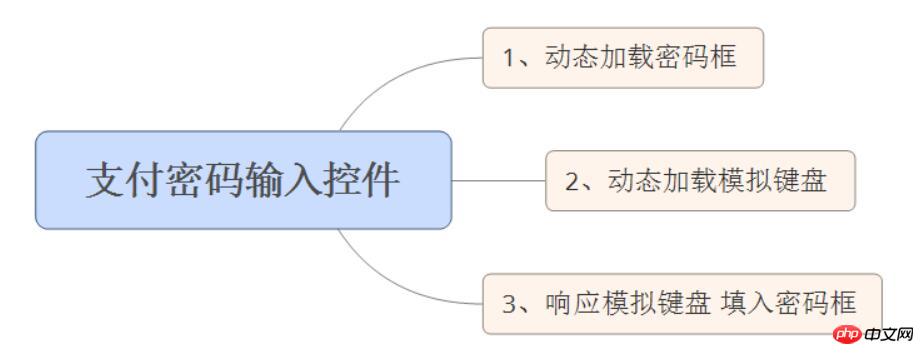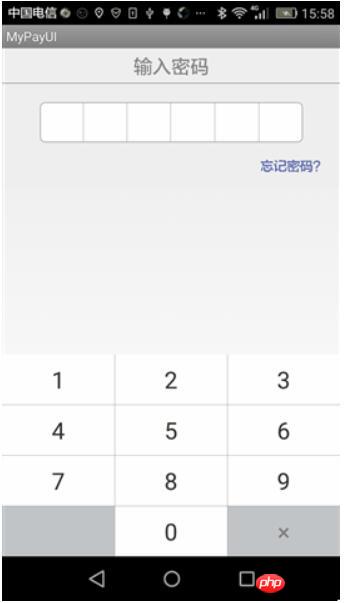Android高仿微信支付密码输入控件实例代码
- 高洛峰原创
- 2017-03-27 13:39:561987浏览
这篇文章主要为大家详细介绍了Android高仿微信支付密码输入控件的具体实现代码,供大家参考,具体内容如下
像微信支付密码控件,在app中是一个多么司空见惯的功能。最近,项目需要这个功能,于是乎就实现这个功能。
老样子,投篮需要找准角度,变成需要理清思路。对于这个"小而美"的控件,我们思路应该这样子。
Ⅰ、将要输入密码数量动态通过代码加载出来。
Ⅱ、利用Gridview模拟产生一个输入数字键盘,并且按照习惯从屏幕底部弹出来。
Ⅲ、对输入数字键盘进行事件监听,将这个输入数字填入到这个密码框中,并且当您输入密码长度一致的时候,进行事件回调。
这个思维导图应该是这样的:

首先,我们要根据需求动态加载密码框,相应的代码如下:
for (int i = 0; i < 6; i++) {
TextView textView = new TextView(context);
android.widget.LinearLayout.LayoutParams layoutParams = new android.widget.LinearLayout.LayoutParams(
0, android.widget.LinearLayout.LayoutParams.WRAP_CONTENT, 1);
textView.setGravity(Gravity.CENTER);
textView.setTransformationMethod(PasswordTransformationMethod.getInstance());
textView.setTextSize(32);
textView.setLayoutParams(layoutParams);
ll_pwd.addView(textView);
if (i != 5) {
View view2 = new View(context);
android.widget.LinearLayout.LayoutParams layoutParams1 = new android.widget.LinearLayout.LayoutParams(
1,
android.widget.LinearLayout.LayoutParams.MATCH_PARENT,
0);
view2.setLayoutParams(layoutParams1);
view2.setBackgroundColor(Color.parseColor("#999999"));
ll_pwd.addView(view2);
}
tvList[i] = textView;
}我们这里密码长度设置为6,将这6个密码框控件添加到盛放这些控件的父控件中去,并且每个密码控件中都有一个分隔控件。并且把每个密码输入控件放入控件数组,以便我们进行接下来的操作。
然后了,我们利用Gridview产生一个12宫格的模拟数字键盘,这样模拟键盘样子是这样的:

源代码应该是这样的:
/**
* 加载数据的代码
*/
private void initData() {
/* 初始化按钮上应该显示的数字 */
for (int i = 1; i < 13; i++) {
Map<String, String> map = new HashMap<String, String>();
if (i < 10) {
map.put("name", String.valueOf(i));
} else if (i == 10) {
map.put("name", "");
} else if (i == 11) {
map.put("name", String.valueOf(0));
} else if (i == 12) {
map.put("name", "×");
} else {
map.put("name", "");
}
valueList.add(map);
}
gridView.setAdapter(adapter);
gridView.setOnItemClickListener(new AdapterView.OnItemClickListener() {
@Override
public void onItemClick(AdapterView<?> parent, View view,
int position, long id) {
if (position < 11 && position != 9) { // 点击0~9按钮
if (currentIndex >= -1 && currentIndex < 5) { // 判断输入位置————要小心数组越界
tvList[++currentIndex].setText(valueList.get(position)
.get("name"));
}
} else {
if (position == 11) { // 点击退格键
if (currentIndex - 1 >= -1) { // 判断是否删除完毕————要小心数组越界
tvList[currentIndex--].setText("");
}
}
}
}
});
}
/**
* GrideView的适配器
*/
BaseAdapter adapter = new BaseAdapter() {
@Override
public int getCount() {
return valueList.size();
}
@Override
public Object getItem(int position) {
return valueList.get(position);
}
@Override
public long getItemId(int position) {
return position;
}
@SuppressWarnings("deprecation")
@Override
public View getView(int position, View convertView, ViewGroup parent) {
ViewHolder viewHolder;
if (convertView == null) {
convertView = View.inflate(context, R.layout.item_gride, null);
viewHolder = new ViewHolder();
viewHolder.btnKey = (TextView) convertView
.findViewById(R.id.btn_keys);
convertView.setTag(viewHolder);
} else {
viewHolder = (ViewHolder) convertView.getTag();
}
viewHolder.btnKey.setText(valueList.get(position).get("name"));
if (position == 9||position==11) {
viewHolder.btnKey.setBackgroundDrawable(Utils.getStateListDrawable(context));
viewHolder.btnKey.setEnabled(false);
}
if (position == 11) {
viewHolder.btnKey.setBackgroundDrawable(Utils.getStateListDrawable(context));
}
return convertView;
}
};
/**
* 存放控件
*/
public final class ViewHolder {
public TextView btnKey;
}
加载模拟键盘上的数据为0-9与x,然后将这个数据通过一个适配器将这些数据填充到这个Gridview控件。这些都是老司机的老套路。按照惯例,这个模拟键盘应该从屏幕的底部弹出,我这里所做的就是将Gridview依附在popupwindow,然后在从屏幕的底部进行弹出。相应的代码如下:
View contentView = LayoutInflater.from(context).inflate(
R.layout.layout_popupdemo, null);// 定义后退弹出框
gridView = (GridView) contentView.findViewById(R.id.gv_keybord);// 泡泡窗口的布局
popupWindow = new PopupWindow(contentView,
ViewGroup.LayoutParams.MATCH_PARENT,// width
ViewGroup.LayoutParams.WRAP_CONTENT);// higth
popupWindow.setFocusable(false);
popupWindow.setAnimationStyle(R.style.animation);
//从底部弹出
public void show() {
popupWindow.showAtLocation(rl_bottom, Gravity.BOTTOM, 0, 0); // 确定在界面中出现的位置
}
@Override
public void onWindowFocusChanged(boolean hasWindowFocus) {
super.onWindowFocusChanged(hasWindowFocus);
show();
}
当这个控件一加载的时候,就弹出。
最后,我们要做的就是监听模拟键盘,将这个模拟键盘的输入填入到密码框,说的貌似很高大上的,其实就是监听Gridview的onitemclick事件,相应代码如下:
gridView.setOnItemClickListener(new AdapterView.OnItemClickListener() {
@Override
public void onItemClick(AdapterView<?> parent, View view,
int position, long id) {
if (position < 11 && position != 9) { // 点击0~9按钮
if (currentIndex >= -1 && currentIndex < 5) { // 判断输入位置————要小心数组越界
tvList[++currentIndex].setText(valueList.get(position)
.get("name"));
}
} else {
if (position == 11) { // 点击退格键
if (currentIndex - 1 >= -1) { // 判断是否删除完毕————要小心数组越界
tvList[currentIndex--].setText("");
}
}
}
}
});
如果用户点击数字0-9,就填入到密码框中,如果是点击退格键的话,就删除所对应密码框的内容。看到没,上文所用文本框数组列表派上了用场。这里值得指出,由于退格键点击效果与众不同,我这里应用代码设置他的样式。
当用户最后一个密码框输入完成之后,就进行输入完成的回调,相应代码为:
// 设置监听方法,在第6位输入完成后触发
public void setOnFinishInput(final OnPasswordInputFinish pass) {
tvList[5].addTextChangedListener(new TextWatcher() {
@Override
public void beforeTextChanged(CharSequence s, int start, int count,
int after) {
}
@Override
public void onTextChanged(CharSequence s, int start, int before,
int count) {
}
@Override
public void afterTextChanged(Editable s) {
if (s.toString().length() == 1) {
strPassword = ""; // 每次触发都要先将strPassword置空,再重新获取,避免由于输入删除再输入造成混乱
for (int i = 0; i < 6; i++) {
strPassword += tvList[i].getText().toString().trim();
}
if (pass!=null) {
pass.inputFinish(); // 接口中要实现的方法,完成密码输入完成后的响应逻辑
}
}
}
});
经过一番折腾以后,大功告成了,最终效果如下:

以上是Android高仿微信支付密码输入控件实例代码的详细内容。更多信息请关注PHP中文网其他相关文章!

